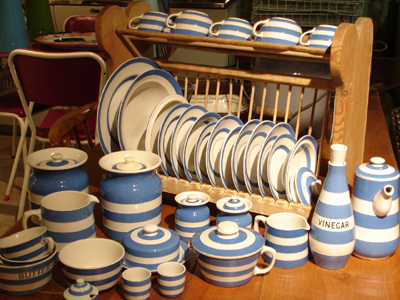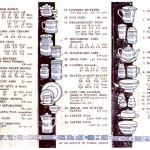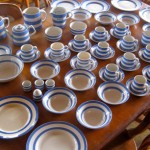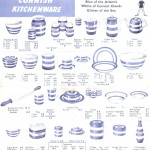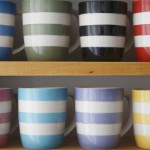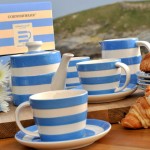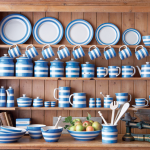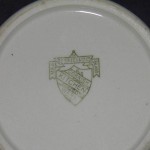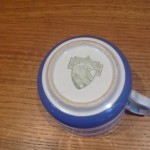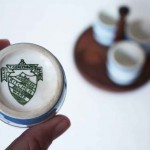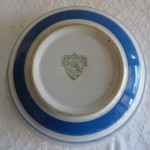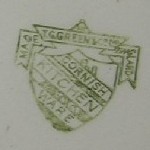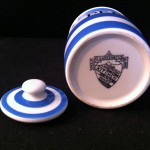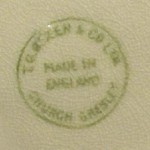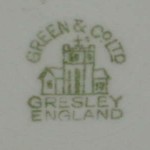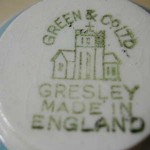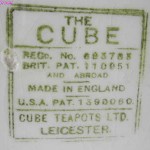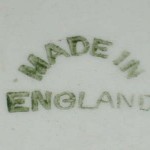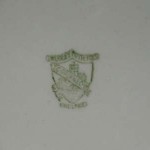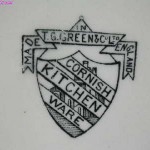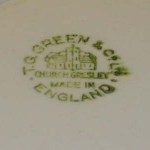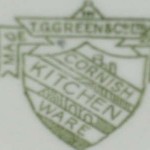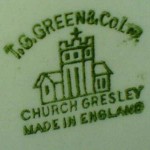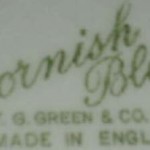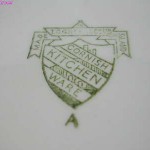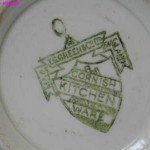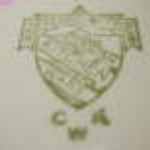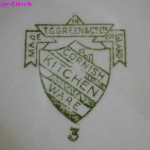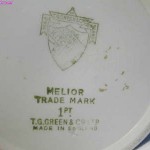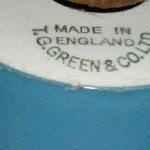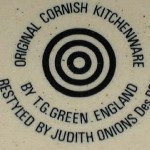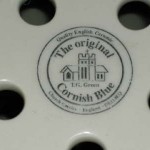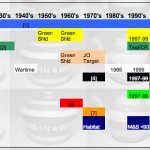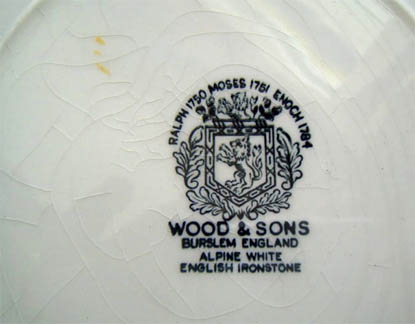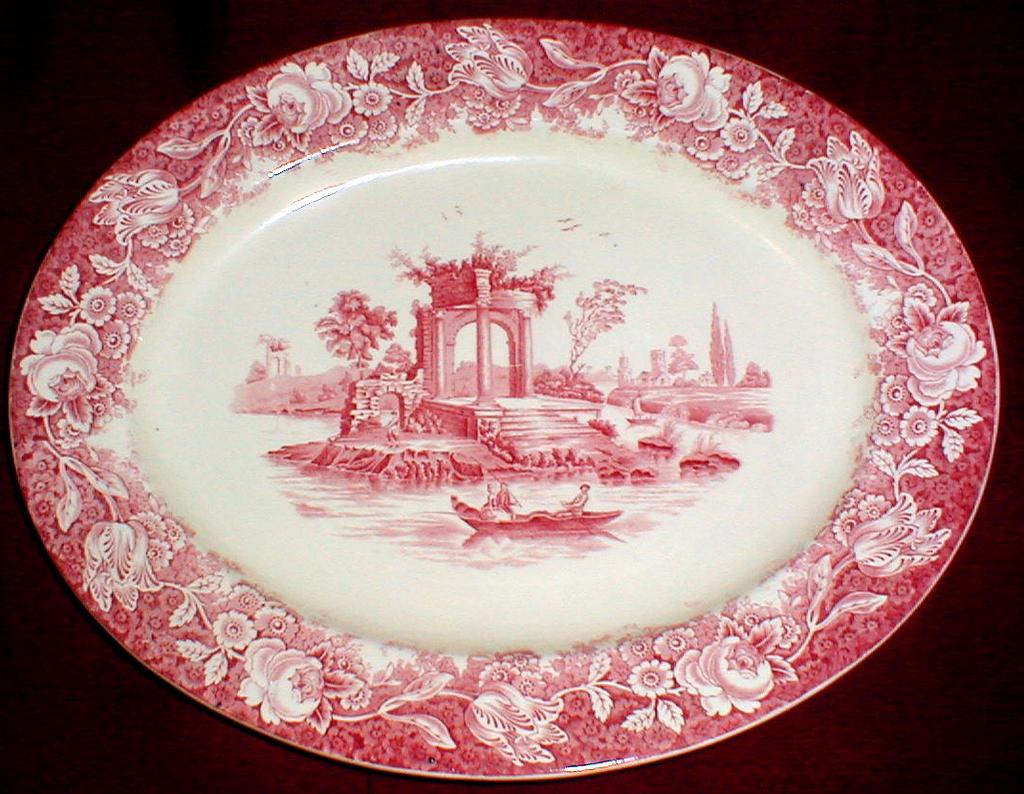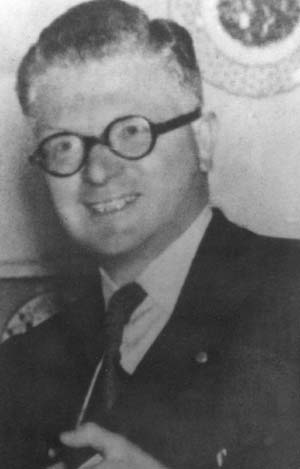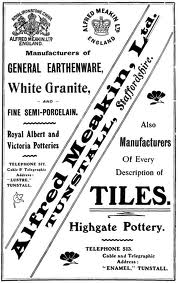The most famous of the ceramics associated with the county of Cornwall, Cornishware, also called Cornish Blue, has always been made in Derbyshire and has no connection at all with Cornwall apart from its name.
We’ve all seen the traditional Cornishware. Even if you aren’t a collector, you will recognize its typical, blue hoops on a white background said to represent the blue of the Cornish sea and the white of its clouds.
The company of T.G. Green is the maker and has been based in Church Gresley, Derbyshire since Thomas Goldwin Green bought the pottery in 1864. The company became very profitable producing kitchen and table wares. It remained in the hands of the family after Thomas G. Green’s death in 1905 and, despite a catastrophic fire, also continued to be successful until the 1950s and 60s when sales declined. It was bought by Cloverleaf in 1987 and is still part of that group.
In the mid 1920s Cornishware was introduced into the company’s range of products and quickly won its first Certificate of the Institute of Hygiene in 1928. It went on to win a Silver Seal from the Institute in 1935. It continued to win Institute awards for another thirty years. Perhaps the most notable result of winning the Institute’s first award was that the company started to promote Cornish Ware for the first time by emphasizing it in catalogues – something it had failed to do when the range was first introduced.
T.G. Green continued to produce Cornish Ware, with just a break during the Second World War. In the 1960s, Cornish Ware was redesigned by Judith Onions and her range has been produced until this year.
It’s very collectable especially the older pieces and although the company went into liquidation in 2009 it was bought from the receiver and continues to produce.
The different kinds of Cornish Ware that can be found are enormous. Of course, there are plates, mugs, cups, saucers, jugs and bowls. There are also rolling pins, clocks, toast racks and flour sifters. There are even tea cosies, tea towels and tablecloths made to match.
Because of its popularity, it became something of a style icon and has been used in advertising for other products like Homepride Flour, who use the distinctive blue and white stripes on their packaging, the Daily Mail, cocoa and even a poster for financial services. All of this gives collectors a chance to find ephemera associated with Cornish Blue.
Some collectors of Cornish Ware concentrate on particular types, for example, just the pieces with names of household products on them. You can find containers with the words Flour, Baking Powder, Milk, Oil, amongst many others.
The beauty for collectors is that some of these were made to order for particular retailers so there are very rare and so more valuable examples. These include include Fish Dripping, Apricots, and Borax.
Dating Cornishware
 Dating is not as straightforward as it is with most other kinds of pottery. Usually backstamps are a good guide but the company didn’t use these in a strictly chronological order, in fact they used more than one during the same periods. This changed when the Judith Onions’ designs were introduced in the 1960s so these can be identified by their backstamps. Although the shapes and positioning of the blue stripes can be an indicator of period, they are not reliable as pieces were made for many years, overlapping with newer designs.
Dating is not as straightforward as it is with most other kinds of pottery. Usually backstamps are a good guide but the company didn’t use these in a strictly chronological order, in fact they used more than one during the same periods. This changed when the Judith Onions’ designs were introduced in the 1960s so these can be identified by their backstamps. Although the shapes and positioning of the blue stripes can be an indicator of period, they are not reliable as pieces were made for many years, overlapping with newer designs.
Cornishware Pottery Marks
- Earliest known backstamp on Cornish Ware (c. 1925)
- Early Church (c. 1930’s)
- Early Church (c. 1930’s)This is a another variety of the Early Church backstamp. ‘Made in England’ rather than ‘England’
- Early Church impressed on Fireproof dish (1930’s)Another unusual variant of the Early Church mark. This one is on a fireproof (oven) dish. Photo courtesy of Sabine Winter, UK.
- The Cube (1930’s)A special backstamp found on the rare Cornishware toastrack and also on some other non-Cornish Kitchen Ware ranges in the ‘Cube’ designs e.g. teapots/sugar bowls etc.
- Made in England (c. 1930’s-40’s)Should usually be in green ink. Not unusual on rolling pins
- Gresley Potteries Shield (c. 1935)A rare mark found primarily on Storage Caddies/Jars and jugs. Estimated c. 1935
- Black Shield (1930’s-1950’s)The vast majority of older Cornish Ware has either a black or a green ‘Shield’. Most storage jars with lettered names have the black shield – be VARY WARY of NAMED jars with a Green Shield which have been known to be plain jars that have been “faked”. This doesnt apply to all jars but is worth noting. You will find genuine green shields on some of the named pieces such as oil, vinegar and sauce bottles and butter dishes, so dont be afraid of these! Its just the storage jars to be careful of. Both of the normal shield markings occasionally have a letter in the same ink directly above/below the shield – the letter ‘O’ seems to crop up a reasonable amount of times. We are not sure of exactly what this means.
- Circular Early Church (c. mid-late 1930’s)This is a seldom seem variant of the early church backstamp and occurs on some interesting pieces like the first cheese dish, fixed base preserve pots etc.
- Green Shield (c.1930’s-mid 1960’s)Note that most NAMED storage/spice jars should NOT have this backstamp (i.e. in Green ink). There have been known fakes utilising doctored plain jars which nearly always have a Green Shield bacsktamp. There are however some legitimate jars that are OK with a Green Shield, particularly those that were exported from the UK to the USA. Also some jars seem only to have a Green Shield (e.g. “Cookies”). Legitimate examples of the spice jar “Caraway-Seeds “have also been noted with a Green Shield.
- Early Church (c.late 1930’s-1950’s)A slightly later version of the Early Church backstamp with full ‘T.G Green & Co Ltd’ reference.
- Rare 1st ‘Cornish Blue’ backstamp (c. 1950)You will almost certainly not see more than 1 of these! We have only come across it once ourselves on the back of a dinner plate.
- Green Shield with extra letter below (c. 1950)The reason for the extra letter is unknown. It is usually either an ‘O’ or an ‘A’. Best guess is that it was a ‘batch mark’ used to indicate its intended shipping destination, possibly by retailer or country.
- Green Shield with extra letter above (c. 1950)
- Green Shield with unusual extra 3 letters (c.1950)
- Green Shield with number below (c. 1950)
- Green Shield with Melior trade mark c. 1950Found on the rare Melior Cafetiere with classic art deco style handle. These were produced in 2 different sizes.
- Semi-Circular mark (c.1950’s)The usual mark found on rolling pins but also on some other smaller items.
- Judith Onions Target Mark (c. 1968 – 1975)Judith Onions (aka JO) restyled the Cornish Ware range in 1967, with most of the redesigned shapes remaining in production until well after Cloverleaf purchased T.G. Green in the late 1980’s. Generally most pieces were ‘straightened out’ in line with the modernism of the time. So curves were generally replaced with clean lines. The main exception was a redesign of some small pudding bowls and large batter bowls into a globe shape, and the wonderfully kidney shaped cruet set base tray. You should not see this backstamp on the experimental colours e.g. Black & White/Orange & White (in theory!)
- Judith Onions Target Mark (c. 1968-1975)This is another variant with Judith Onions reference
- Mason Cash Cornish Blue (mid 2002-mid 2003)Mason Cash begin to brand ‘The Original Cornish Blue’. Backstamps in black or blue ink but without Mason Cash reference.

